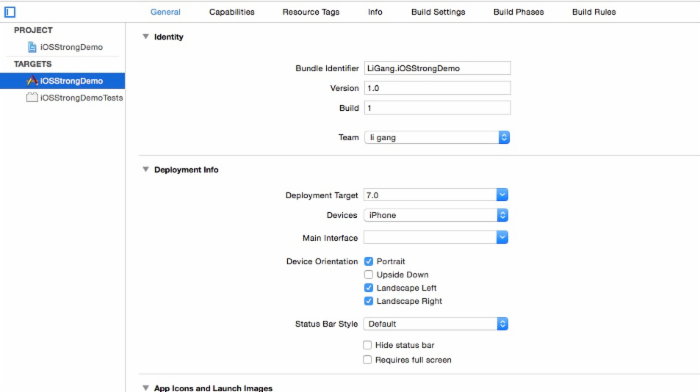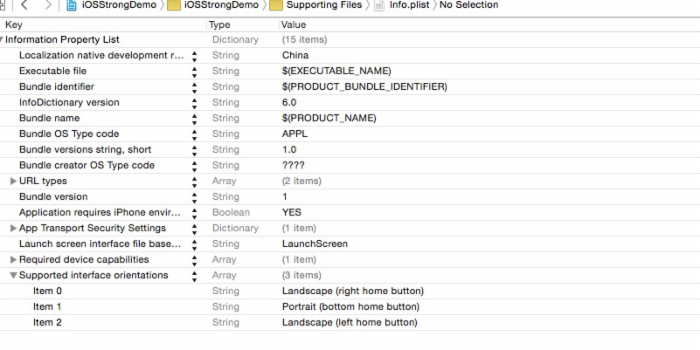iOS9横竖屏设置的处理方法和实例讲解
在一般的视频类APP播放的时候都会支持横屏,这样做的好处就是便于观看。你的项目中支持横屏吗?我们一起了解一下,在iOS9中横竖屏设置的处理方法吧!
支持横竖屏配置
在iOS6以后,如果APP需要支持横屏,需要在xcode设置中General里面进行勾选配置:

配置完成之后,我们可以看一下Info.plist里面的Supported interface orientations选项也相应的改变了。如下图:

当然,我们也可以直接在Info.plist进行配置。
支持横竖屏方法
在iOS6之前我们可以直接用这个方法进行配置:
- (BOOL)shouldAutorotateToInterfaceOrientation:(UIInterfaceOrientation)toInterfaceOrientation NS_DEPRECATED_IOS(2_0, 6_0) __TVOS_PROHIBITED; 在iOS6之后,这个方法被NS_DEPRECATED_IOS,也就是废弃掉了。废弃了这个方法,苹果相应的也给出了新的方法来代替:
// New Autorotation support. - (BOOL)shouldAutorotate NS_AVAILABLE_IOS(6_0) __TVOS_PROHIBITED; - (UIInterfaceOrientationMask)supportedInterfaceOrientations NS_AVAILABLE_IOS(6_0) __TVOS_PROHIBITED; 我们可以看到iOS6之前是一个方法,在iOS6之后变成两个方法了,一个是是否旋转的方法,一个是支持的方向的方法。
实例一:
假设:我们ViewController是直接加载window的self.window.rootViewController上面的。代码如下:
- (BOOL)application:(UIApplication *)application didFinishLaunchingWithOptions:(NSDictionary *)launchOptions { // Override point for customization after application launch. self.window = [[UIWindow alloc] initWithFrame:[[UIScreen mainScreen] bounds]]; ViewController *vc = [[ViewController alloc] init]; self.window.rootViewController = vc; [self.window makeKeyAndVisible]; return YES; } 如果我们要是想支持上面General里勾选的方向(竖屏、横屏向左已经横屏向右)该如何实现呢?首先,我们应该设置让他支持旋转,然后在设置支持的方向。代码如下:
//支持旋转 -(BOOL)shouldAutorotate{ return YES; } //支持的方向 - (UIInterfaceOrientationMask)supportedInterfaceOrientations { return UIInterfaceOrientationMaskAllButUpsideDown; } 其中UIInterfaceOrientationMask是一个枚举:
typedef NS_OPTIONS(NSUInteger, UIInterfaceOrientationMask) { UIInterfaceOrientationMaskPortrait = (1 << UIInterfaceOrientationPortrait), UIInterfaceOrientationMaskLandscapeLeft = (1 << UIInterfaceOrientationLandscapeLeft), UIInterfaceOrientationMaskLandscapeRight = (1 << UIInterfaceOrientationLandscapeRight), UIInterfaceOrientationMaskPortraitUpsideDown = (1 << UIInterfaceOrientationPortraitUpsideDown), UIInterfaceOrientationMaskLandscape = (UIInterfaceOrientationMaskLandscapeLeft | UIInterfaceOrientationMaskLandscapeRight), UIInterfaceOrientationMaskAll = (UIInterfaceOrientationMaskPortrait | UIInterfaceOrientationMaskLandscapeLeft | UIInterfaceOrientationMaskLandscapeRight | UIInterfaceOrientationMaskPortraitUpsideDown), UIInterfaceOrientationMaskAllButUpsideDown = (UIInterfaceOrientationMaskPortrait | UIInterfaceOrientationMaskLandscapeLeft | UIInterfaceOrientationMaskLandscapeRight), } __TVOS_PROHIBITED; 可以根据自己的需求来选择。上面我们说了假设这个条件,如果rootViewController上导航,我们直接在ViewController里面设置,这个方法就不灵了。(大家可以自己测试一下)
实例二:
为什么是导航上面的方法就不灵了呢?原因很简单,我们没有设置导航支持的方向。别忘了UINavigationController也是UIViewController的子类。需要受到同样的待遇的。
如何设置呢?我们可以创建一个UINavigationController的子类,假设叫GGPublicNavigationViewController。然后,我们在GGPublicNavigationViewController.m文件里面也实现着两个方法:
//支持旋转 -(BOOL)shouldAutorotate{ return YES; } //支持的方向 - (UIInterfaceOrientationMask)supportedInterfaceOrientations { return UIInterfaceOrientationMaskAllButUpsideDown; } 这样设置之后,即使我们push进去的UIViewController没有实现上面的连个方法,也是可以支持横屏的。也就是说,我们push的所有都支持横屏。这个做法是不是很暴力!
实例三:
有些童鞋会问了,如何控制每个界面支持的方向呢?这也是可以办到的,在GGPublicNavigationViewController不能写死支持哪个。我们可以这么写:
-(BOOL)shouldAutorotate{ return [self.topViewController shouldAutorotate]; } //支持的方向 - (UIInterfaceOrientationMask)supportedInterfaceOrientations { return [self.topViewController supportedInterfaceOrientations];; } self.topViewController是当前导航显示的UIViewController,这样就可以控制每个UIViewController所支持的方向啦!
好啦,关于iOS9中横竖屏的处理就说这么多吧!(其实iOS7、iOS8也是这么设置的)如果你觉得文章还不错,分享一下吧!











![[HBLOG]公众号](https://www.liuhaihua.cn/img/qrcode_gzh.jpg)

